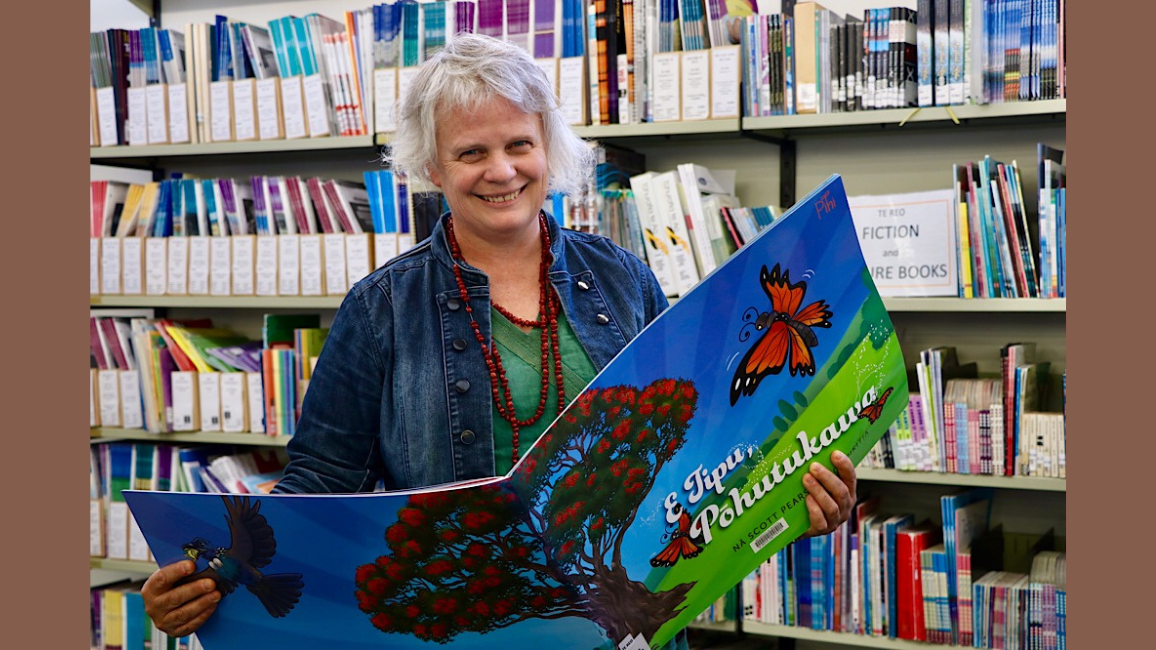Te Wiki o te Reo Māori continues with this installment of The Reckoning from University of Waikato senior lecturer Nicola Daly, where she explores different approaches to text layout in bilingual picture books! With a growing number of options in the reorua/bilingual Māori-English picture books available, it’s a perspective we were interested to read about.

For many years in Aotearoa, most picturebooks with Māori text have existed separately from their English counterparts, rather than integrating the two languages in one. Exclusively Māori-language editions are particularly important in Māori medium educational settings, given how dominant English is in every other aspect of the students’ lives.
But more recently, in addition to these much needed and treasured separate versions of books, there seems to have been an increase in the availability of books with both English and Māori in one edition, as well as more options integrating English and Pasifika languages. When it comes to designing the layout of a picturebook to accommodate text in two languages, there are a number of ways that designers go about it. I’ve been considering how the different approaches to the size and placement of the text work to identify different audiences or imagined readers.
When it comes to designing the layout of a picturebook to accommodate text in two languages, there are a number of ways that designers go about it.
This idea of modifying the way we use language based on who we are communicating with has been discussed in children’s literature in terms of the imagined reader, which American researcher Dr Patricia Larkin-Lieffers defines as ‘the imagined person to whose response the author is shaping the book and who would share the author’s attitudes, feelings and values’.
The New Zealand sociolinguist Allan Bell also developed a theory to explain how we change our language depending on who we are communicating with with a theory called Audience Design. Basically, it comes down to this: in a spoken interaction we mostly know who we are talking to, but in a picturebook situation we may imagine a reader and have an audience in mind . . . but we can never be sure of who will pick up the book and ultimately be the audience. However, the way an author or publisher presents language in a picturebook can help decide who the audience may be.
…but we can never be sure of who will pick up the book and ultimately be the audience.
Let’s go through the options of text layout and think about two things. Firstly, who is the intended audience? And secondly, what does the layout communicate to the readers about the relative status of the two languages?
On the same page
The first design approach has both languages presented on the same page in the same sized font, one above the other, and because both English and te reo Māori are read from top to bottom, as a reader I’ll assume that whichever language comes first is most important. For example, in a book like Kei Te Pehea Koe?, by Tracy Duncan, the Māori text comes first, so this book appears to be designed for readers who wish to learn Māori, with English there as a support. It could also be read by Māori language speakers, but it is unlikely that fluent readers of te reo would need or desire the presence of English.
Verso and recto
In the second option, one language is presented on the left-hand page (verso) and the other on right-hand page (recto) of a double page spread, and because western print is read from left to right, the left hand page language appears more important. This occurs in Te Koha a Tangaroa/Tangaroa’s Gift, by Mere Whaanga, so I would assume that it favours readers of Māori, but is also accessible to readers of English on each page. This book was published only a few years after the Māori language was given official status in New Zealand as a result of the Māori Language Act of 1987, when there were very few bilingual picturebooks available, so the presence of both Māori and English may have had a particularly symbolic meaning, reflecting the era in which it was published.
…the presence of both Māori and English may have had a particularly symbolic meaning, reflecting the era in which it was published.
Different typefaces
In the third option, different typefaces are used. If one language is given in a bold typeface, or a larger typeface, this can lead to the assumption that the language using bold or larger font is more important. In books such as Reo Pepi’s Kanohi, Māori text is larger than the English text, and it is in bold which would seem to imply that the intended, or imagined reader or audience, is one who wishes to prioritise te reo with the potential support of smaller English text below.
Different sections
The fourth option is one in which one language is given in the first part of the book with only that language on each page—and the second language follows after, in a kind of second chapter to the book. Again, because I read from left-to-right and front-to-back, I assume that whichever language comes first is more important.
In Kia Ora: You Can Be A Kiwi Too, English text is given first and te reo Māori in a second ‘chapter’. As a reader I take this to mean that in this book, the primary imagined reader or audience is English language dominant. The Māori text is presented on half the number of pages given to the English text, and illustrations have been reduced —both of which may communicate to the audience, however unintentionally, that this language is not as important.
Please note here that my critique of the layout is in no way critical of the work of the author and illustrator, whose work I really admire. I am simply exploring aspects of layout.
Tête bêche
A final format which can be used to present two languages in a picturebook is called ‘tête bêche’, which literally means ‘head to tail’, and refers to something that is printed inverted in relation to each other. It is similar to the different chapters approach except that the two texts are given in a different orientation. If you hold the book one way you can read it in one language to the middle of the book, and if you turn the book over and the other way up, you can read it in the other language.
This format may be the only one that doesn’t privilege one language over the other, as the languages do not compete for space on the page, and they are each given equal space and illustration. We can see it used in the book Te Tiriti o te Whare Rākau/The Tree House Treaty, where it speaks to a te reo Māori dominant reader as much as it does an English language dominant reader. It also provides some support for a language learning reader who is confident in one language and needing a little support for the other language—although that support requires a reorientation of the book to access.
This format may be the only one that doesn’t privilege one language over the other, as the languages do not compete for space on the page…
So to summarise, there are a few main points that I think are core to how we present text in Māori-English bilingual picturebooks: For one, the way languages are set out in bilingual picturebooks matters. Secondly, the layout links to audience and implied readers – as well as suggesting or reinforcing the status of different languages. And finally, the layout can support language learners in different ways.
Ultimately, my argument is this. When we are working with indigenous languages, such as te reo Māori, it is really important to be aware of the messages being sent via the layout of picturebooks and the imagined audience being implied. So if we are trying to influence language attitudes to create positive attitudes to an endangered indigenous language, we have the power within a dual language picturebook to contribute positively to the kaupapa of revitalisation.
…we have the power within a dual language picturebook to contribute positively to the kaupapa of revitalisation.
At the very least, we can give it as much space as the dominant language, with the same quality of illustrations, and type size. But additionally we can put it first and give it a larger font to encourage awareness and learning of our indigenous language amongst our imagined audience, future citizens and leaders.
Editors’ note: The Reckoning is a regular column where children’s literature experts air their thoughts, views and grievances. They’re not necessarily the views of the editors or our readers. We would love to hear your response to any of The Reckonings – join in the discussion over on Facebook.

Nicola Daly
Nicola Daly is a senior lecturer at Te Kura Toi Tangata, in the Division of Education at the University of Waikato where she teaches courses in children's literature and language learning. Her courses 'An Introduction to Children's Literature' and 'New Zealand Children's Literature Paper' are both offered online. Nicola's research examines the use of languages in picturebooks; she has had fellowships at the Marantz Picture book Collection at Kent State University, the International Youth Library in Munich, Germany, and most recently was a Fulbright New Zealand Scholar based at the Worlds of Words Center, University of Arizona, USA. She runs a picturebook club for University of Waikato staff and students and is the Co-Director of the Waikato Picture Book Research Unit which runs an annual seminar at the Hamilton Campus (November 12 2020 Silent Picturebooks). Registration is at waikato.ac.nz/go/waipru-seminar.



